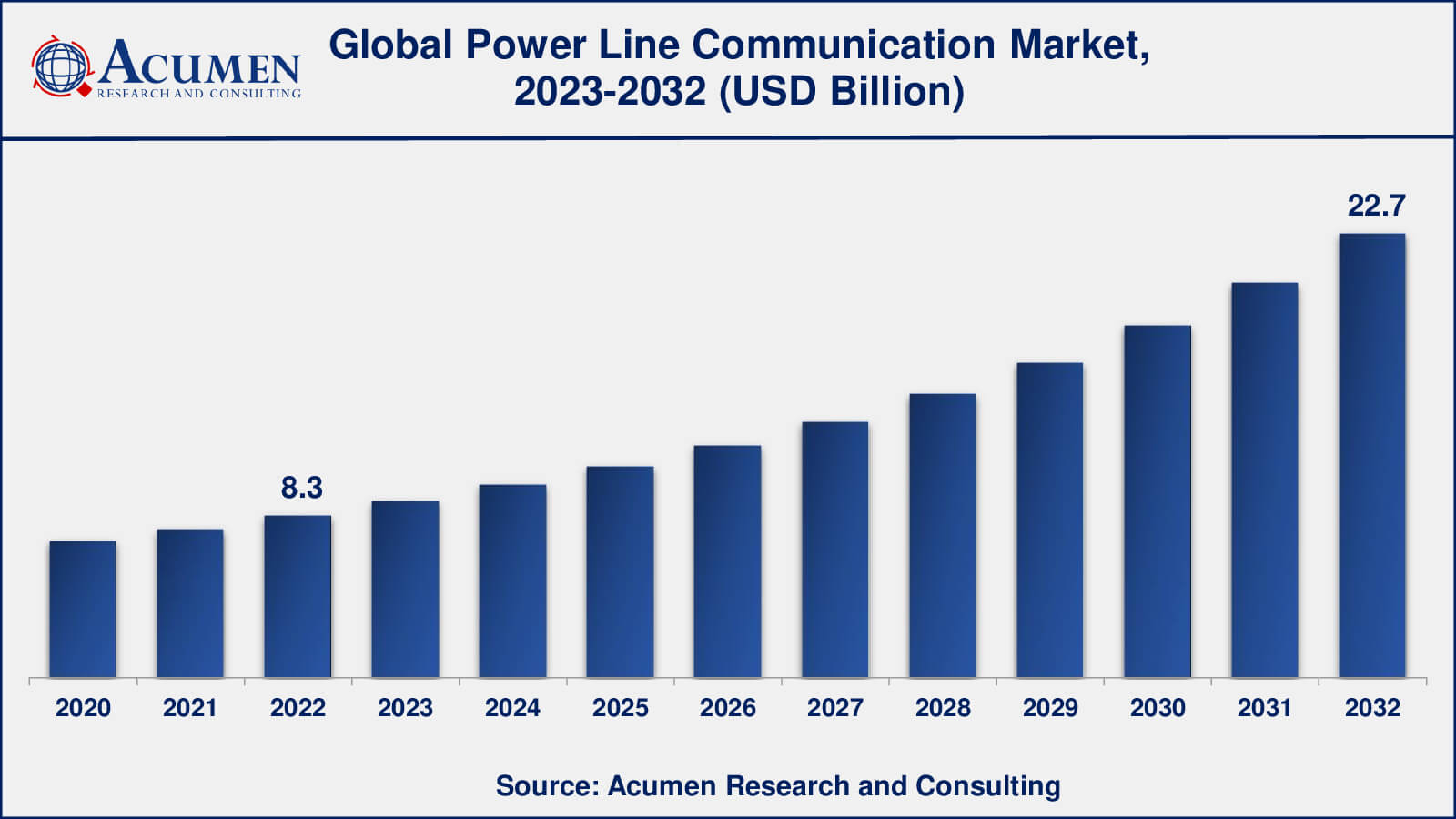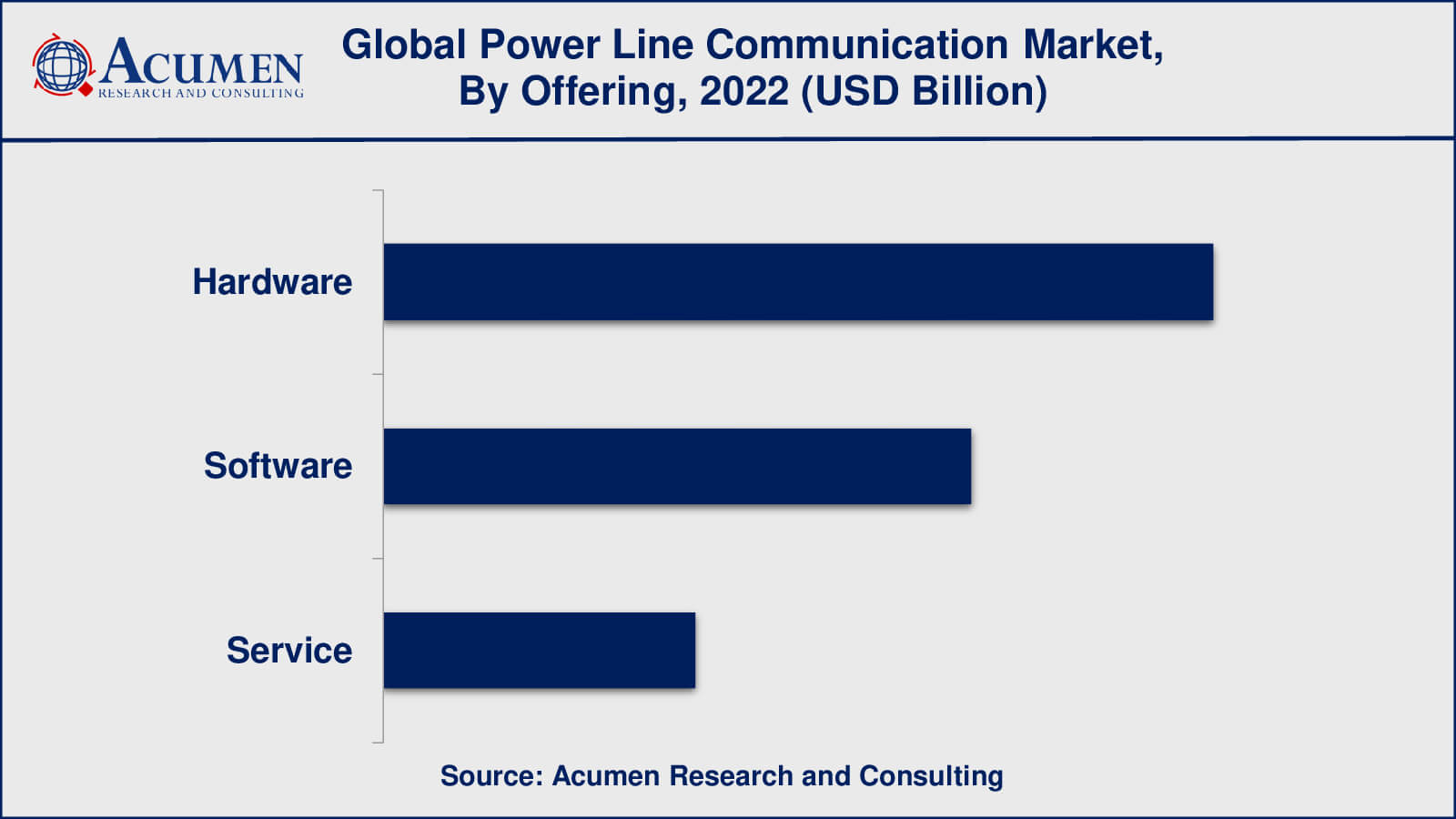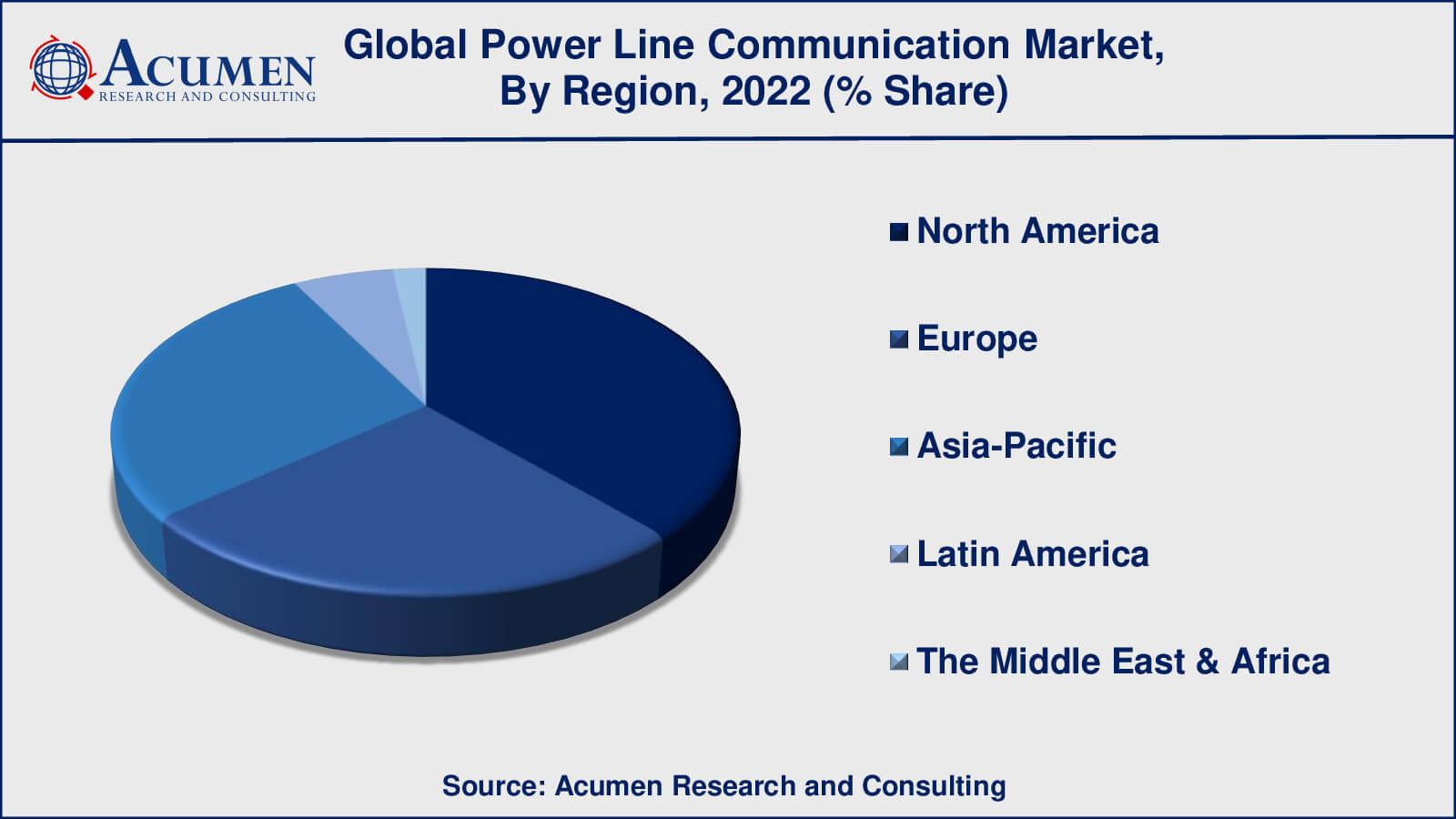Power Line Communication Market Size - Global Industry, Share, Analysis, Trends and Forecast 2023 - 2032
Published :
Report ID:
Pages :
Format :
Power Line Communication Market Size - Global Industry, Share, Analysis, Trends and Forecast 2023 - 2032
Report Coverage
- Industry Dynamics
- Market Size and Forecast Data
- Segment Analysis
- Competitive Landscape
- Regional Analysis with a Niche Focus on Country-Level Data
- High Level Analysis - Porter's, PESTEL, Value Chain, etc.
- Company Profiles of Key Players
- Option to Customize the Report As Per Your Specific Need
Request Sample Report
The Global Power Line Communication Market Size accounted for USD 8.3 Billion in 2022 and is estimated to achieve a market size of USD 22.7 Billion by 2032 growing at a CAGR of 10.8% from 2023 to 2032.
Power Line Communication Market Highlights
- Global power line communication market revenue is poised to garner USD 22.7 billion by 2032 with a CAGR of 10.8% from 2023 to 2032
- North America power line communication market value occupied around 3.2 billion in 2022
- Asia-Pacific power line communication market growth will record a CAGR of more than 11% from 2023 to 2032
- Among offering, the hardware sub-segment generated over US$ 3.9 billion revenue in 2022
- Based on application, the smart grids sub-segment generated around 40% share in 2022
- Integration of PLC with emerging technologies for enhanced functionality is a popular market trend that fuels the industry demand

Power line communication (PLC) is a system that transmits data messages over existing electrical power lines. It makes use of the power grid infrastructure to transfer data alongside the usual power supply, allowing devices to communicate without the need for special communication lines. PLC is in high demand for a variety of reasons. For starters, it makes use of existing power grid infrastructure, minimizing the need for additional communication connections. This makes it especially helpful in situations where laying new connections or developing wireless communication networks would be costly or difficult.
Second, PLC is a low-cost option. Because electricity lines are already in existence, utilizing them for communication saves money on the costs of constructing separate communication networks and equipment. As a result, PLC is an appealing solution for both home and commercial applications. Finally, PLC gives extensive coverage. Power lines may reach almost every corner of a building or a residential neighborhood, allowing communication linkages to be established without the distance or impediments that might hinder wireless signals. Overall, PLCs provide a practical and cost-effective approach to enable device communication over existing power lines, making them an increasingly popular alternative in a variety of sectors and applications.

Global Power Line Communication (PLC) Market Dynamics
Market Drivers
- Growing demand for power line communication solutions
- Increasing preference for cost-effective communication options
- Rising need for leveraging existing infrastructure for communication purposes
- Growing interest in industrial automation and control systems
Market Restraints
- Limited commercial availability of advanced PLC systems
- Complexity and high cost hindering widespread adoption
- Lack of standardization in power line communication protocols
- Technical limitations in terms of bandwidth and signal quality
- Security concerns regarding data transmission over power lines
Market Opportunities
- Advancements in power line communication technology
- Increasing research and development efforts in the field
- Rising demand for IoT connectivity and smart home applications
- Expanding market for electric vehicle charging infrastructure
Power Line Communication Market Report Coverage
| Market | Power Line Communication Market |
| Power Line Communication Market Size 2022 | USD 8.3 Billion |
| Power Line Communication Market Forecast 2032 | USD 22.7 Billion |
| Power Line Communication Market CAGR During 2023 - 2032 | 10.8% |
| Power Line Communication Market Analysis Period | 2020 - 2032 |
| Power Line Communication Market Base Year | 2022 |
| Power Line Communication Market Forecast Data | 2023 - 2032 |
| Segments Covered | By Frequency, By Offering, By Application, By Industry Vertical, And By Geography |
| Regional Scope | North America, Europe, Asia Pacific, Latin America, and Middle East & Africa |
| Key Companies Profiled | ABB Ltd., Belkin International, Inc., General Electric Company, Huawei Technologies Co., Ltd., Maxim Integrated Offerings, Inc., Mitsubishi Electric Corporation, Netgear, Inc., Schneider Electric SE, Siemens AG, STMicroelectronics N.V., Texas Instruments Incorporated, and Yamar Electronics Ltd. |
| Report Coverage |
Market Trends, Drivers, Restraints, Competitive Analysis, Player Profiling, Covid-19 Analysis, Regulation Analysis |
Power Line Communication PLC Market Insights
Several reasons have led to the increased demand and implementation of power line communication (PLC) technology. The use of existing infrastructure is one of the primary factors. PLC makes use of the power grid infrastructure, allowing data to be sent via existing electrical power lines. This removes the need for additional communication lines, making it a cost-effective alternative, particularly in locations where constructing new cables or creating wireless networks may be difficult or expensive.
Another key driver for the PLC industry is cost-effectiveness. The costs of constructing separate communication networks are reduced by using existing power lines. Because it provides a quick and cost-effective means of communication, PLC is an appealing solution for both home and business applications.
The extensive coverage of PLC is another motivator. Power lines may be found in almost every corner of a structure or residential neighborhood, providing wide coverage and communication reach. This overcomes the distance and blockage limits that might affect wireless communications, making PLC an intriguing alternative for applications requiring dependable communication.
The growing need for smart grids has propelled the PLC market's expansion. PLCs are critical in the development of smart grids because they enable efficient energy management, metering, and control systems. It enables the smooth integration of numerous smart devices and offers real-time data monitoring and control capabilities, hence improving energy efficiency and grid management.
However, the PLC market is not without its hurdles and limits. One such barrier is limited bandwidth. Power lines were intended primarily for the transfer of power, and their capability for data communication is restricted. This can have an impact on data transmission speed and throughput through PLC systems.
In the PLC sector, signal attenuation and noise interference are significant issues. Power lines can cause signal attenuation and noise, lowering the quality and dependability of PLC communications. Attempts are being made to alleviate these problems and enhance the overall performance of PLC systems.
Furthermore, compatibility issues occur owing to varying power line standards and regional differences. This might lead to interoperability concerns between PLC devices made by various vendors, preventing seamless integration and communication.
Despite these obstacles, the PLC market offers several options. Technological and methodology advancements continue to improve PLC systems, allowing for larger data rates, increased signal quality, and improved performance. PLC's growing applications in smart homes, IoT connection, electric car charging infrastructure, and energy management systems present significant development potential.
Finally, the power line communication market is driven by the use of existing infrastructure, cost-effectiveness, extensive coverage, and desire for smart grid technology. Despite constraints such as restricted bandwidth and compatibility concerns, the market continues to provide prospects for innovation and expansion across several industry sectors.
Power Line Communication Market Segmentation
The worldwide market for power line communication is split based on offering, frequency, application, industry vertical, and geography.
PLC Market Offerings
- Hardware
- Software
- Energy Management
- Data Acquisition and Management
- Service
- Professional Service
- Maintenance & Repair

According to power line communication industry analysis, hardware components such as power line communication modems, adapters, chips, and controllers are crucial for establishing the communication link over power lines. These hardware components, which constitute the backbone of PLC systems, are required for delivering and receiving data signals.
However, it is crucial to highlight that the PLC industry is multidimensional, and software and services also play major roles in promoting and implementing PLC solutions. The creation of PLC protocols, algorithms, and firmware that enable efficient data transfer and communication via power lines is included in the software offerings. Management and control systems for monitoring and optimising PLC networks are often included in software solutions.
PLC solution providers and system integrators, on the other hand, provide consultancy, installation, integration, maintenance, and support services. These services are critical for aiding clients with the implementation and management of PLC systems, as well as guaranteeing their smooth functioning and addressing any difficulties that may develop.
While hardware has typically dominated the PLC industry because to its fundamental function, software and services are equally significant and complement hardware solutions. To fulfil unique client needs and provide efficient and reliable communication via power lines, a thorough and effective deployment of PLC solutions frequently comprises a combination of hardware, software, and services.
PLC Market Frequencies
- Narrowband
- Broadband
According to our analysis, narrowband PLC frequencies are commonly employed. Narrowband PLC works at lower frequencies, often less than 500 kHz. It is extensively used for smart grid connectivity, automated metre reading (AMR), and home automation. The benefit of narrowband PLC is its capacity to communicate over long distances and easily overcome electrical cables and obstructions.
Broadband PLC, on the other hand, has gained pace in recent years, particularly with the demand for high-speed data transfer and multimedia applications. Broadband PLC runs at higher frequencies, often in the tens of megahertz range. It has faster data speeds and is appropriate for internet access, video streaming, and sophisticated smart home systems. Broadband PLC enables speedier communication while also enabling bandwidth-intensive services.
It is crucial to note that the choice of narrowband or broadband PLC frequencies is influenced by a variety of parameters such as the unique application requirements, intended data rates, distance, noise interference, and regulatory limits. PLC usage may be governed by different frequency allocations and laws in different areas and nations.
The relative importance of narrowband or broadband frequencies in the PLC market varies depending on the application and market area. Narrowband frequencies were once more common due to their proven use in utility and AMR applications. However, as broadband PLC technology progresses, there is an increasing desire in higher-frequency broadband solutions to handle larger data rates and multimedia applications.
PLC Market Applications
- Networking
- Smart Grid
- Long-Haul
According to power line communication market forecast, smart grid refers to the integration of digital communication and advanced technologies into the electrical power grid infrastructure to enable efficient energy management, grid monitoring, and control systems.
As per the power line communication market forecast, the smart grid application has been a dominant segment. PLC technology has played a crucial role in the development and implementation of Smart Grid solutions. It facilitates communication between various components within the grid, such as smart meters, distribution automation systems, substations, and control centers. PLC enables real-time data transmission over power lines, allowing for remote monitoring, control, and optimization of the grid infrastructure.
With the increasing focus on energy efficiency, demand response programs, and renewable energy integration, the Smart Grid application has gained significant traction. PLC-based Smart Grid solutions offer benefits such as improved metering accuracy, remote meter reading, load balancing, fault detection, and real-time energy consumption monitoring.
While the Smart Grid application has been dominant, PLC technology has also found applications in other segments. Networking applications, such as home automation, building management systems, and internet connectivity, have also contributed to the growth of the PLC market. PLC enables communication and networking capabilities within residential and commercial environments, allowing for the integration and control of various devices and systems.
PLC Market Industry Verticals
- Commercial
- Residential
- Industrial
- Automotive & Transportation
- Energy & Power
In the power line communication (PLC) market, the residential industry vertical has been a prominent segment. The employment of PLC technology in homes and residential contexts is referred to as residential applications. PLC is widely used in residential settings for a variety of applications, including home automation, smart home systems, energy management, and Internet of Things (IoT) connection. PLCs provide for communication and networking through power lines, enabling for the integration and management of diverse devices and systems within residential premises. Lighting control, HVAC systems, security systems, smart appliances, and multimedia devices are examples of such applications. The residential sector's dominance in the PLC market may be ascribed to rising demand for smart homes, energy-efficient solutions, and an increase in the number of connected devices in residential settings. PLC has benefits such as ease of installation, cost-effectiveness (because to the use of existing power lines), and reliable communication within residences.
While PLCs have experienced widespread adoption in the residential sector, the technology has also found uses in other business sectors. Building automation, energy management, and communication networks have all been used by the commercial sector, which includes office buildings, retail spaces, and commercial complexes. PLC has also piqued the interest of the industrial sector for applications such as industrial automation, control systems, and monitoring in manufacturing plants and industrial facilities. PLCs provide communication between diverse industrial equipment and systems, resulting in improved process control and optimisation.
Power Line Communication Market Regional Outlook
North America
- U.S.
- Canada
Europe
- U.K.
- Germany
- France
- Spain
- Rest of Europe
Asia-Pacific
- India
- Japan
- China
- Australia
- South Korea
- Rest of Asia-Pacific
Latin America
- Brazil
- Mexico
- Rest of Latin America
The Middle East & Africa
- South Africa
- GCC Countries
- Rest of the Middle East & Africa (ME&A)

Power Line Communication Market Regional Analysis
North America has been a significant market for PLC, owing to the availability of improved electrical infrastructure, a focus on smart grid efforts, and the deployment of advanced communication technologies. PLC deployments in utility, residential, and commercial sectors have been considerable in the United States and Canada.
Europe has been a pioneer in PLC adoption and commercial development. Several European nations have launched smart grid projects and energy-efficiency requirements, resulting in broad PLC adoption. PLC deployment has been widespread in countries like as Germany, France, and the United Kingdom, covering residential, commercial, and industrial applications.
The Asia-Pacific region has witnessed growing adoption of PLC technology due to increasing urbanization, industrialization, and infrastructural development. Countries such as China, Japan, South Korea, and India have been driving this region's market expansion. The need for smart home solutions, IoT connection, and effective energy management systems has aided the growth of the Asia Pacific PLC market.
Power Line Communication Market Players
Some of the top power line communication companies offered in our report includes ABB Ltd., Belkin International, Inc., General Electric Company, Huawei Technologies Co., Ltd., Maxim Integrated Offerings, Inc., Mitsubishi Electric Corporation, Netgear, Inc., Schneider Electric SE, Siemens AG, STMicroelectronics N.V., Texas Instruments Incorporated, and Yamar Electronics Ltd.
Frequently Asked Questions
What was the market size of the global power line communication in 2022?
The market size of power line communication was USD 8.3 billion in 2022.
What is the CAGR of the global power line communication market from 2023 to 2032?
The CAGR of power line communication is 10.8% during the analysis period of 2023 to 2032.
Which are the key players in the power line communication market?
The key players operating in the global market are including ABB Ltd., Belkin International, Inc., General Electric Company, Huawei Technologies Co., Ltd., Maxim Integrated Offerings, Inc., Mitsubishi Electric Corporation, Netgear, Inc., Schneider Electric SE, Siemens AG, STMicroelectronics N.V., Texas Instruments Incorporated, and Yamar Electronics Ltd.
Which region dominated the global power line communication market share?
North America held the dominating position in power line communication industry during the analysis period of 2023 to 2032.
Which region registered fastest CAGR from 2023 to 2032?
Asia-Pacific region exhibited fastest growing CAGR for market of power line communication during the analysis period of 2023 to 2032.
What are the current trends and dynamics in the global power line communication industry?
The current trends and dynamics in the power line communication industry include growing demand for power line communication solutions, increasing preference for cost-effective communication options, and rising need for leveraging existing infrastructure for communication purposes.
Which offering held the maximum share in 2022?
The hardware offering held the maximum share of the power line communication industry.?



